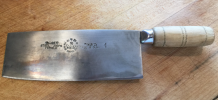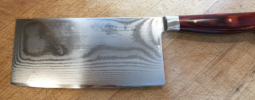- Joined
- Jun 3, 2019
- Messages
- 2,714
I spent yesterday afternoon and evening cooking a chinese banquet for our families with an old friend of mine (who is originally from china). He is an incredibly good cook - and it is always a pleasure to share the stove with him - so I was determined to offer him a wide selection of (sharp) knives for food prep. we both like extremely sharp knives.... The knife below I bought about 30 years ago, and over the years has been extremely well used:

this knife can no longer be found (except on Ebay), is from china, and is made from a pretty soft steel (guessing at something like 55-57 rockwell). Here is the point: about 12 years ago my wife decided to use this knife to chop through some bones - with the result of some really nasty chips at the heel of the edge. the knife has been sitting since then waiting for me to get around to "repairing" it. yesterday I decided to do so in case my friend would want to use it. (please ignore The rather nasty looking grind at the edge, which is a result of a test to see whether there was any way to re-bevel at least a portion of the blade (turns out not possible - way too much warp in the blade - to really bevel the edge would result in the spine making contact with t he belt - unless I played games with moving way up to the top of the platen, which I did not want to do).
Here is the point: once focusing just on the edge (not the bevel), with a 120 grit belt with this softer steel, I was able to re-profile the edge to convexity, then get enough of a local bevel in place, followed by a 15 degree edge (using 400 grit belt) to get this blade back to full usefullness, and screaming sharp. Took maybe 20 minutes. Now I fully realize that this edge will not keep long - but the conflict I have is that maintaining a blade and bringing it back to full sharpness with these softer steels is SO EASY and fast. If it gets a little dull which doing food prep, 30 seconds with the ribbed steel pretty much brings that performance back. If I really want back that screaming sharp blade (which I usually do!), it is 5 minutes work on the grinder and it is done.
Compare that with a harder steel, for example this VG-10 blade at 62 Rockwell:

Yes, the edge is sharp, and will stay that way longer than that softer old timer .... but if I am in the middle of food prep and I discover it is not performing, NO WAY would I expose the blade to a steel (can you say edge chips??). Working on the grinder would also take longer, and also require more heat management so as to not kill the temper.
I am truly torn: there is definitely something about the newer and harder steels in their ability to gain a really sharp edge - but it is what comes after, during wear and use and when you are in the middle of food prep, and it takes more time and care to bring back that edge (and you dont have that time, because you need to get that food onto the table.....) where the softer steels seem to be more "forgiving".
I strongly suspect I am going to get hammered on this, because so much focus here is on advanced, harder, steels during manufacture .... but I continue to wonder whether a softer steel is still quite beneficial from a maintainability/ quick sharpen-ability perspective. What say you all???

this knife can no longer be found (except on Ebay), is from china, and is made from a pretty soft steel (guessing at something like 55-57 rockwell). Here is the point: about 12 years ago my wife decided to use this knife to chop through some bones - with the result of some really nasty chips at the heel of the edge. the knife has been sitting since then waiting for me to get around to "repairing" it. yesterday I decided to do so in case my friend would want to use it. (please ignore The rather nasty looking grind at the edge, which is a result of a test to see whether there was any way to re-bevel at least a portion of the blade (turns out not possible - way too much warp in the blade - to really bevel the edge would result in the spine making contact with t he belt - unless I played games with moving way up to the top of the platen, which I did not want to do).
Here is the point: once focusing just on the edge (not the bevel), with a 120 grit belt with this softer steel, I was able to re-profile the edge to convexity, then get enough of a local bevel in place, followed by a 15 degree edge (using 400 grit belt) to get this blade back to full usefullness, and screaming sharp. Took maybe 20 minutes. Now I fully realize that this edge will not keep long - but the conflict I have is that maintaining a blade and bringing it back to full sharpness with these softer steels is SO EASY and fast. If it gets a little dull which doing food prep, 30 seconds with the ribbed steel pretty much brings that performance back. If I really want back that screaming sharp blade (which I usually do!), it is 5 minutes work on the grinder and it is done.
Compare that with a harder steel, for example this VG-10 blade at 62 Rockwell:

Yes, the edge is sharp, and will stay that way longer than that softer old timer .... but if I am in the middle of food prep and I discover it is not performing, NO WAY would I expose the blade to a steel (can you say edge chips??). Working on the grinder would also take longer, and also require more heat management so as to not kill the temper.
I am truly torn: there is definitely something about the newer and harder steels in their ability to gain a really sharp edge - but it is what comes after, during wear and use and when you are in the middle of food prep, and it takes more time and care to bring back that edge (and you dont have that time, because you need to get that food onto the table.....) where the softer steels seem to be more "forgiving".
I strongly suspect I am going to get hammered on this, because so much focus here is on advanced, harder, steels during manufacture .... but I continue to wonder whether a softer steel is still quite beneficial from a maintainability/ quick sharpen-ability perspective. What say you all???
